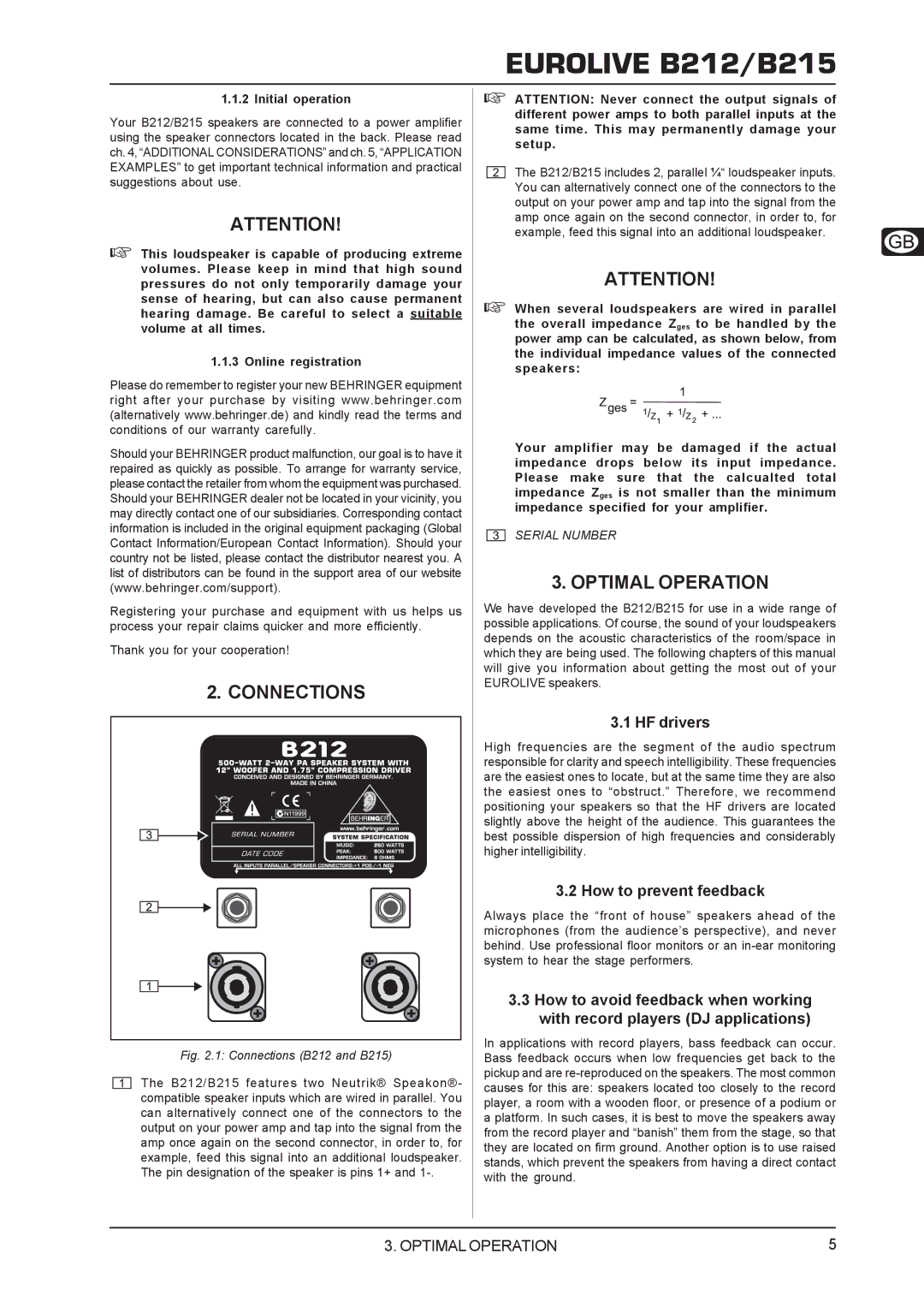
EUROLIVE B212/B215
1.1.2 Initial operation
Your B212/B215 speakers are connected to a power amplifier using the speaker connectors located in the back. Please read ch. 4, “ADDITIONAL CONSIDERATIONS” and ch. 5, “APPLICATION EXAMPLES” to get important technical information and practical suggestions about use.
ATTENTION!
This loudspeaker is capable of producing extreme volumes. Please keep in mind that high sound pressures do not only temporarily damage your sense of hearing, but can also cause permanent hearing damage. Be careful to select a suitable volume at all times.
1.1.3 Online registration
Please do remember to register your new BEHRINGER equipment right after your purchase by visiting www.behringer.com (alternatively www.behringer.de) and kindly read the terms and conditions of our warranty carefully.
Should your BEHRINGER product malfunction, our goal is to have it repaired as quickly as possible. To arrange for warranty service, please contact the retailer from whom the equipment was purchased. Should your BEHRINGER dealer not be located in your vicinity, you may directly contact one of our subsidiaries. Corresponding contact information is included in the original equipment packaging (Global Contact Information/European Contact Information). Should your country not be listed, please contact the distributor nearest you. A list of distributors can be found in the support area of our website (www.behringer.com/support).
Registering your purchase and equipment with us helps us process your repair claims quicker and more efficiently.
Thank you for your cooperation!
2. CONNECTIONS
Fig. 2.1: Connections (B212 and B215)
The B212/B215 features two Neutrik® Speakon®- compatible speaker inputs which are wired in parallel. You can alternatively connect one of the connectors to the output on your power amp and tap into the signal from the amp once again on the second connector, in order to, for example, feed this signal into an additional loudspeaker. The pin designation of the speaker is pins 1+ and
ATTENTION: Never connect the output signals of different power amps to both parallel inputs at the same time. This may permanently damage your setup.
The B212/B215 includes 2, parallel ¼“ loudspeaker inputs. You can alternatively connect one of the connectors to the output on your power amp and tap into the signal from the amp once again on the second connector, in order to, for example, feed this signal into an additional loudspeaker.
ATTENTION!
When several loudspeakers are wired in parallel the overall impedance Zges to be handled by the power amp can be calculated, as shown below, from the individual impedance values of the connected speakers:
Your amplifier may be damaged if the actual impedance drops below its input impedance. Please make sure that the calcualted total impedance Zges is not smaller than the minimum impedance specified for your amplifier.
SERIAL NUMBER
3. OPTIMAL OPERATION
We have developed the B212/B215 for use in a wide range of possible applications. Of course, the sound of your loudspeakers depends on the acoustic characteristics of the room/space in which they are being used. The following chapters of this manual will give you information about getting the most out of your EUROLIVE speakers.
3.1 HF drivers
High frequencies are the segment of the audio spectrum responsible for clarity and speech intelligibility. These frequencies are the easiest ones to locate, but at the same time they are also the easiest ones to “obstruct.” Therefore, we recommend positioning your speakers so that the HF drivers are located slightly above the height of the audience. This guarantees the best possible dispersion of high frequencies and considerably higher intelligibility.
3.2 How to prevent feedback
Always place the “front of house” speakers ahead of the microphones (from the audience’s perspective), and never behind. Use professional floor monitors or an
3.3How to avoid feedback when working with record players (DJ applications)
In applications with record players, bass feedback can occur. Bass feedback occurs when low frequencies get back to the pickup and are
3. OPTIMAL OPERATION | 5 |
